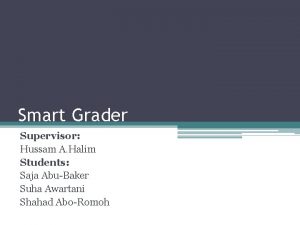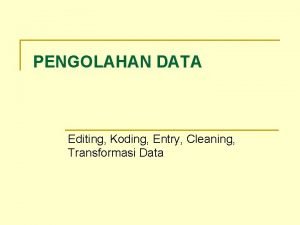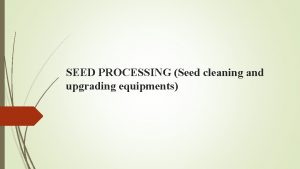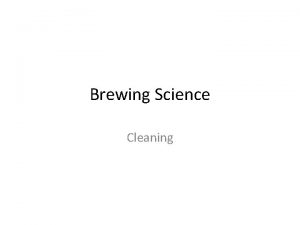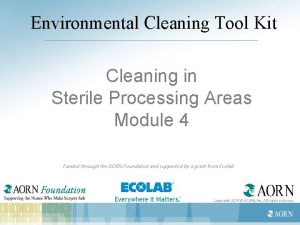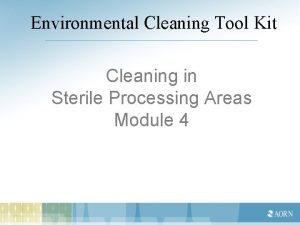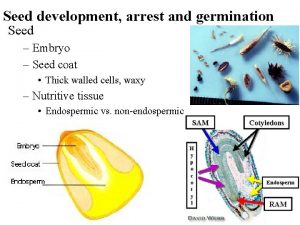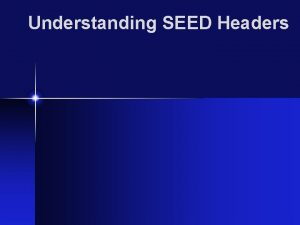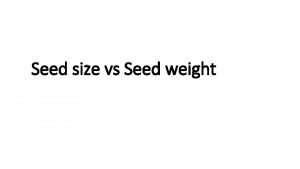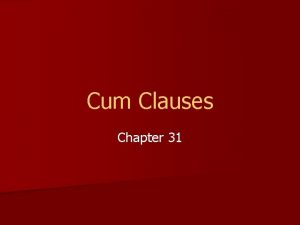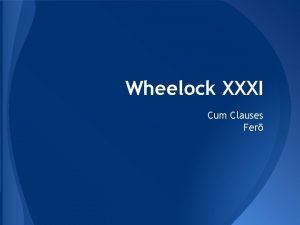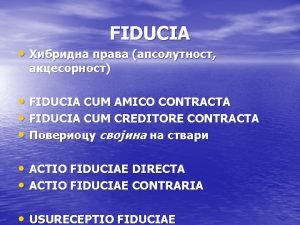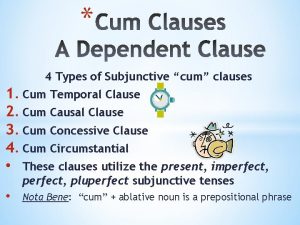SEED PROCESSING EQUIPMENTCLEANER CUM GRADER SEED CLEANING I
















- Slides: 16

SEED PROCESSING EQUIPMENTCLEANER CUM GRADER

SEED CLEANING I. Air screen cleaner Ø This is the most important machine of every cleaning plant. It uses screens and aspiration (air blow) for two separations Ø A coarse upper screen removes larger material, a lower fine screen stops the seeds and lets through fine matter and then the seed fraction passes through a transverse or nearly vertical air stream which can separate light impurities such as empty or partly filled seeds, husks and glumes from the seed Ø In most cases a number of sieves with different sized perforations are used and the cleaning is a process of gradually shifting out smaller particles Ø Factors which determine the quality and quantity of seed cleaned include (i) size of the perforations (ii) the precision of the perforation (iii) the angle at which the sieves operate (iv) the amplitude and speed of movement of the sieves (v) correct cleaning and maintenance of the equipment

Air screen cleaner

II. Cleaner cum grader The dried seeds should be cleaned and graded with help of a cleaner cum grader. For large scale cleaning and grading the commonly available machine is the “Crippen Model Seed Cleaner cum Grader”. It consists of the following parts • A hopper in the top for seed filling • A flutted roller below the hopper to regulate the seed flow to the screen • Screen (or) sieves: Perforated metal sheet with specific size of perforation in which there are two types • Rectangular perforations for paddy • Round perforations for seed other than paddy • Screen shaking unit : for oscillating the sieves to move the seeds on the screens • Screen brushes to remove the blocked seeds • Air blower with adjustments for air outlet • Collecting outlet • Air duct for directing the blown up light particles to outside • Collecting bins.

• Adjustments: 1. Flutted roller: The speed of this roller can be adjusted so as to increase (or) decrease the flow of seeds to the hopper of the sieves. 2. Slope (or) inclination of the screen: The angle of inclination of the screens can be adjusted according to the nature of seeds. Rate of vibration of sieve This can be adjusted either to increase or to decrease the speed of the rolling seeds on the screen. 3. Volume of air flow: By increasing (or) decreasing the air inlet. Choice of screens: According to variety we have to change the screen 4. Screen dams: Small check dams, which can be provided here and there on the screens so that the seeds can be stopped a while and takes the charge either to pass or to roll • Types of seed cleaner cum grader i) Crippen model cleaner cum grader ii) Clipper model cleaner cum grader iii) Petkas cleaner cum grader

Cleaner cum grader

Seed upgrading equipments Type of upgrading Operations & types of Machines Principle of operation of the equipment 1. a. Uses of the machine Sizing and Grading 1. Horizontal flat screen separator eg. Clipper corn sizer, superior cork-it-corn grader 2. Vertical ribbed screen separator eg. Dockins seed grader 3. Cylindrical screen separator These machines make extremely sensitive separations on the basis of differences in width and thickness. The seeds are sized for width by using round hole screen openings and for thickness by using slotted screen openings. The separators employ gravity, centrifugal force, product pressure or a combination of these forces to make the separation. 1. Removal of splits from soybeans, peanuts etc. 2. The removal of chips and splits from sorghum seeds 3. Removal of cheat from wheat 4. Removal of cockleburs from cotton seed, wild onion from fescue, and wild oats from a. Length sizing and grading Seeds are separated on pure length basis 1. Disc Separator In disc separator the disc lifts uniformly shaped and sized and under sized particles out of a mass of seed. The separation is not affected by seed coat texture, weight or moisture content 1. 2. 3. 4. 1. Width and Thickness sizing and grading Cylinder separator The cylinder separator operates on a centrifugal force principle in which the speed of the cylinder holds seed in the indents, lifting them out of the mass until the indents are inverted to the point where gravity causes the particles to fall. Shape and size of the indents and seed, seed coat texture moisture content and weight of seed all combine to affect seed separation Removal of weed seeds Cross broken crop seeds To upgrade general appearance Size grade for precision planting

2. Gravity or Weight separations 1. Gravity separator 2. Stoners The gravity separator employs a flotation principle. In this separation seeds are vertically stratified in layers on the deck according to density. Seeds of same size are stratified and separated by differences in their specific gravity. The oscillating movement of the table walks the heavy seeds in contact with the deck uphill while the air floats the light seeds downhill. The seeds travelling to the edge of the table range from light at the lower end to heavy at the upper end. The discharge can be divided into any number of density fractions 1. 2. 3. 4. Removal of badly deteriorated diseased seed and insect damaged seed Removal of empty or sterile seed Removal of soil particles and gravel and send mixed with certain kind of seeds Removal of contaminating crop or weed seed It is a modified gravity separator designated to Removal of heavy inert material from a larger make two parts of separations by differences in volume of seed gravity

3. Air separations 1. Pneumatic Separator It uses the movement of air to divide seeds according 1. General cleaning to their terminal velocities. Terminal velocity refers to 2. Close grading the velocity of air required to suspend particles in a 3. Specific separation rising air current. Many factors such as density shape and surface and texture effect resistance of a particle to airflow. When the seed is introduced into an air stream all the particles with lightweight are lifted by the velocity of the air, while the seeds with heavy weight fall below. In pneumatic air separator the air is blown through the fan which lifts the light material and the seeds which are light in weight 2. Aspirator In aspirator the fan is at discharge end and induces a vacuum, which allows the atmospheric pressure to force air through the separator 3. Fractional Aspirator In fractional aspirator when a seed mixture is introduced into the lower end of an expanding air column, heavy seeds fall against the airflow and light seeds are lifted. Air velocity through the expanding columns lessens and gradually drops out seeds with lower terminal velocities. Each outlet along the column receives a lighter fraction of seeds the mixture is thereby separated into several grades

4. Surface Texture Separation 1. Roll Mill 2. Magnetic separator 3. Inclined Draper The velvet roll mill classifies seeds according to a difference Separation of smooth clover seeds eg. From rough seed in texture of seed coat. When a seed mixture is fed on to the coats, seeds with irregular shape, wrinkle or shrivelled seeds, upper end of the rolls, the smooth seeds travel down hill broken, clipped or damaged seeds rough or irregular shaped between them and are discharged at the lower end. Rough- inert material coated seeds caught in the velvet take a bouncing path between shield and rolls and are thrown over sides. The discharge from the sides of the rolls is caught is several directions. The roughest seeds are ejected first Magnetic superiors take advantage of the surface texture and stickiness of seed to make a separation. A seed mixture and proportionate amount of water and finely ground iron powder are mixed in a screw conveyor or other mixing device. In the presence of moisture, the iron powder will adhere to rough cracked and sticky seeds. When the mixture is fed to the top of a horizontal revolving magnetic drum Separation of smooth or round seeds from rough, flat or smooth or sticky seeds that are relatively free of iron powder elongated seed all from the drum, while the rough textured seeds with iron powder stick to the drum until they are removed by a rotary brush The inclined draper separator senses differences in shape and surface texture to separate seed on an inclined plane. A mixture to be separated is metered on to the center of an inclined draper belt travelling in an uphill direction. Round or smooth seeds, which roll or slide down the draper, faster than the draper travelling upwards. Flat or rough-coated seeds are carried to the top of the inclined plane and dropped into a separate hopper

5. Electronic separation Electric color sorters 6. Other Separators 1. Spiral separator 1. Polishers 1. Picker belts The electric color sorter separates the seeds on the Separation of off coloured seeds basis of difference in color brightness. One type of machine picks up the seeds on a series of suction fingers and carries them to a phototube where they are judged for colour brightness and ejected into separate containers one at a time The spiral separator makes a division of seed Separation of rape and soybean seeds from wheat, oat according to shape or the degree of its ability to roll. and rye grass. Similarly, separation of flat and The separator resembles a stationary open screw wrinkled seed of soybean from smooth seed conveyor standing on end. The mixture fed onto the spiral at the top, slides or rolls down the inclined surface. The fast rolling seeds gain speed and are thrown by centrifugal force into an outer housing, which directs them to a chute below. The slow rolling seeds remain on the inner inclined surface and enter a second chute at the bottom To improve the lusture of the seeds. Eg. Beans peas, Polishers use a polishing agent such as sawdust or bran popcorn etc to remove discoloration. In some of the polishers mild mechanical rubbing action is provided Removal of undesirable ears of corn, pods from shelled Separations that cannot be made by machines may be peanuts and other specific contaminants made by hand on hand picker belts. The maize cobs are fed on one end of the moving belt. Operators examine the cobs and that which are of offtypes are removed by hand





THANK YOU
 Smart grader
Smart grader Jackson pollock born
Jackson pollock born Are you smarter than a 5th grader lyrics
Are you smarter than a 5th grader lyrics What is the average quantile measure for a 6th grader
What is the average quantile measure for a 6th grader Kompass 270 grader
Kompass 270 grader Editing coding entry cleaning
Editing coding entry cleaning What is point processing in digital image processing
What is point processing in digital image processing Morphological dilation
Morphological dilation Top-down processing vs bottom-up processing
Top-down processing vs bottom-up processing Histogram processing in digital image processing
Histogram processing in digital image processing Top-down processing vs bottom-up processing
Top-down processing vs bottom-up processing Point processing and neighbourhood processing
Point processing and neighbourhood processing Parallel processing vs concurrent processing
Parallel processing vs concurrent processing Bottom up processing example
Bottom up processing example Batch processing and interactive processing
Batch processing and interactive processing Secondary processing of wheat
Secondary processing of wheat پردازش تصویر
پردازش تصویر
